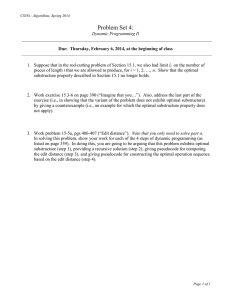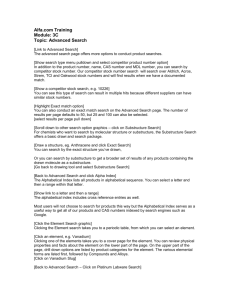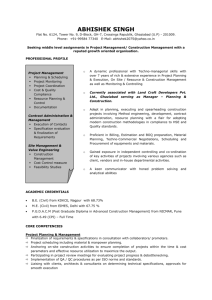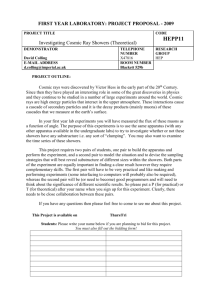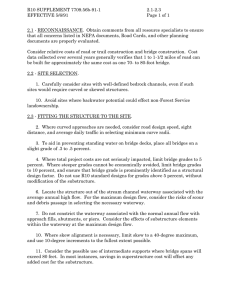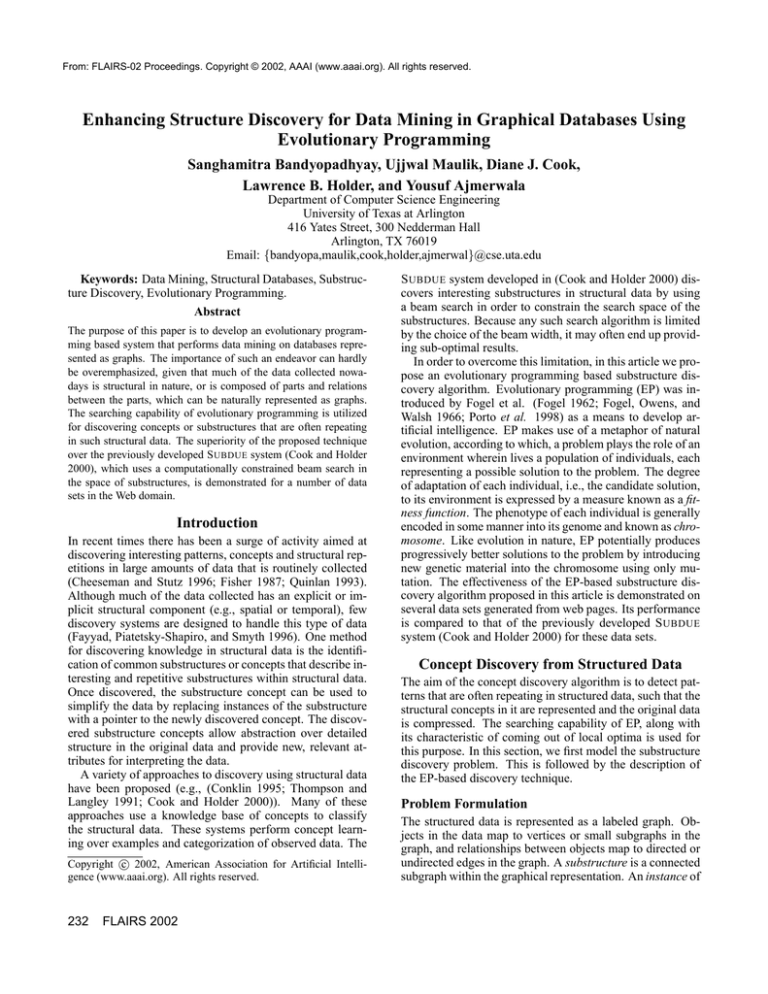
From: FLAIRS-02 Proceedings. Copyright © 2002, AAAI (www.aaai.org). All rights reserved.
Enhancing Structure Discovery for Data Mining in Graphical Databases Using
Evolutionary Programming
Sanghamitra Bandyopadhyay, Ujjwal Maulik, Diane J. Cook,
Lawrence B. Holder, and Yousuf Ajmerwala
Department of Computer Science Engineering
University of Texas at Arlington
416 Yates Street, 300 Nedderman Hall
Arlington, TX 76019
Email: {bandyopa,maulik,cook,holder,ajmerwal}@cse.uta.edu
Keywords: Data Mining, Structural Databases, Substructure Discovery, Evolutionary Programming.
Abstract
The purpose of this paper is to develop an evolutionary programming based system that performs data mining on databases represented as graphs. The importance of such an endeavor can hardly
be overemphasized, given that much of the data collected nowadays is structural in nature, or is composed of parts and relations
between the parts, which can be naturally represented as graphs.
The searching capability of evolutionary programming is utilized
for discovering concepts or substructures that are often repeating
in such structural data. The superiority of the proposed technique
over the previously developed S UBDUE system (Cook and Holder
2000), which uses a computationally constrained beam search in
the space of substructures, is demonstrated for a number of data
sets in the Web domain.
Introduction
In recent times there has been a surge of activity aimed at
discovering interesting patterns, concepts and structural repetitions in large amounts of data that is routinely collected
(Cheeseman and Stutz 1996; Fisher 1987; Quinlan 1993).
Although much of the data collected has an explicit or implicit structural component (e.g., spatial or temporal), few
discovery systems are designed to handle this type of data
(Fayyad, Piatetsky-Shapiro, and Smyth 1996). One method
for discovering knowledge in structural data is the identification of common substructures or concepts that describe interesting and repetitive substructures within structural data.
Once discovered, the substructure concept can be used to
simplify the data by replacing instances of the substructure
with a pointer to the newly discovered concept. The discovered substructure concepts allow abstraction over detailed
structure in the original data and provide new, relevant attributes for interpreting the data.
A variety of approaches to discovery using structural data
have been proposed (e.g., (Conklin 1995; Thompson and
Langley 1991; Cook and Holder 2000)). Many of these
approaches use a knowledge base of concepts to classify
the structural data. These systems perform concept learning over examples and categorization of observed data. The
c 2002, American Association for Artificial IntelliCopyright gence (www.aaai.org). All rights reserved.
232
FLAIRS 2002
S UBDUE system developed in (Cook and Holder 2000) discovers interesting substructures in structural data by using
a beam search in order to constrain the search space of the
substructures. Because any such search algorithm is limited
by the choice of the beam width, it may often end up providing sub-optimal results.
In order to overcome this limitation, in this article we propose an evolutionary programming based substructure discovery algorithm. Evolutionary programming (EP) was introduced by Fogel et al. (Fogel 1962; Fogel, Owens, and
Walsh 1966; Porto et al. 1998) as a means to develop artificial intelligence. EP makes use of a metaphor of natural
evolution, according to which, a problem plays the role of an
environment wherein lives a population of individuals, each
representing a possible solution to the problem. The degree
of adaptation of each individual, i.e., the candidate solution,
to its environment is expressed by a measure known as a fitness function. The phenotype of each individual is generally
encoded in some manner into its genome and known as chromosome. Like evolution in nature, EP potentially produces
progressively better solutions to the problem by introducing
new genetic material into the chromosome using only mutation. The effectiveness of the EP-based substructure discovery algorithm proposed in this article is demonstrated on
several data sets generated from web pages. Its performance
is compared to that of the previously developed S UBDUE
system (Cook and Holder 2000) for these data sets.
Concept Discovery from Structured Data
The aim of the concept discovery algorithm is to detect patterns that are often repeating in structured data, such that the
structural concepts in it are represented and the original data
is compressed. The searching capability of EP, along with
its characteristic of coming out of local optima is used for
this purpose. In this section, we first model the substructure
discovery problem. This is followed by the description of
the EP-based discovery technique.
Problem Formulation
The structured data is represented as a labeled graph. Objects in the data map to vertices or small subgraphs in the
graph, and relationships between objects map to directed or
undirected edges in the graph. A substructure is a connected
subgraph within the graphical representation. An instance of
Substructure
Input Graph
T1
S1
pe
sha
C1
triangle
object
R1
T2
T3
T4
S2
S3
S4
on
e
ap
sh
square
object
Figure 1: Example substructure in graph form.
a substructure in an input graph is a set of vertices and edges
from the input graph that match, graph theoretically, to the
graphical representation of the substructure. This graphical
representation serves as input to the substructure discovery
system. Figure 1 shows a geometric example of a database.
The graph representation of the discovered substructure is
also shown, and one of the four instances of the substructure
is highlighted in the picture.
Evolutionary Programming for Substructure
Identification
EP belongs to the same category of evolutionary computation as genetic algorithms (GAs) (Goldberg 1989;
Michalewicz 1992; Mitchell 1996), the primary differences
being (i) EP does not place any constraint on the representation, while GA usually requires the problem solutions to
be encoded as strings, and (ii) EP does not use any sexual
reproduction (or crossover), while crossover is one of the
fundamental operators in GA. In EP only mutation is applied on the parent chromosomes to produce offspring. The
offspring are then evaluated in the same way as their parents.
Subsequently the next generation is selected from collection
of both the parents and the offspring. This process is repeated for a number of generations until some termination
criterion is attained. In this regard, EP is quite similar to
evolutionary strategies (ES) (Schwefel 1987), although the
two approaches evolved independently.
A chromosome in the EP-based discovery scheme contains a pointer to a substructure in the graph. Since performing crossover between two such chromosomes, each pointing to just a single substructure, is not really meaningful, we
mainly rely on the mutation and selection operators to lead
us to potentially better solutions. This was the main motivation behind using EP (instead of the more commonly used
GA) as the underlying search and optimization tool for the
task of substructure discovery from graphical data.
The substructure discovery algorithm used by the EPbased technique is shown in figure 2. Here G is the input graph, Pop-Size denotes the number of chromosomes in
the population and Limit is the maximum number of iterations of EP. The first task in the EP-based discovery algorithm is the generation of the initial population which is
done randomly. The substructures in the initial population
consist of a single edge with two vertices. These substructures are evaluated, and the value is assigned to the fitness of
the corresponding chromosomes. Mutation is used to perturb a chromosome to generate a new one, which are then
evaluated. Selection is performed on the set of parent and
mutated chromosomes to yield the next generation. The cycle of fitness evaluation, mutation and selection continues
for a number of generations until a termination criterion is
attained. The different steps of the proposed technique are
described below.
Population Initialization: All possible substructures
having a single edge with two vertices are generated in the
following way: For each unique vertex label, a substructure
is assembled whose definition is a vertex with that label, and
whose instances are all of the vertices in G with that label.
Each of these substructures is inserted in ParentList. Each
substructure is then in turn removed from the head of ParentList, and each of its instances is extended in all possible
ways. This is done by adding a new edge and vertex in G
to the instance. The first instance of each unique expansion
becomes a definition for a new child substructure, and all of
the child instances that were expanded in the same way (i.e.,
by adding the same new edge with new vertex to the same
old vertex) become instances of that child substructure. In
addition, child instances that were generated by different expansions, and that match the child substructure definition,
graph theoretically, also become instances of the child substructure. The substructure definition and its instances are
inserted in the ChildList. For each chromosome in the initial
population, its pointer is set to the address of a substructure
randomly selected from ChildList.
Fitness Evaluation: The substructure S pointed to by a
chromosome is evaluated based on its size, SizeOf (S), and
the size of the graph G compressed using S, SizeOf (G, S).
The lower the value of SizeOf (G, S) + SizeOf (S),
the better is the discovered substructure in terms of its
compressability. Note that since our aim is to minimize this quantity, we define the fitness of a chromosome, which needs to be maximized, to be equal to
1
SizeOf (S)+SizeOf (G,S) .
Mutation: Mutation is similar to the process of generating the substructures for initializing the population. During
mutation of a chromosome, the substructure S that it points
to is extracted. Each of the instances of S is extended in all
possible ways. The first instance of each unique expansion
becomes a definition for a new child substructure S , and all
of the child instances that were expanded in the same way
(i.e., by adding the same new edge or new edge with new
vertex to the same old vertex) become instances of that child
substructure. In addition, child instances that were generated by different expansions, and that match S within the
matchcost threshold also become instances of S . The substructure definition S and its instances are inserted in the
ChildList. After all the instances of S have been extended,
and the ChildList is complete, a substructure S is randomly
selected from the ChildList. The chromosome is then made
to point to S . The mutated chromosomes are appended to
the parent population, ChromList.
Selection and Elitism: Fitness proportional selection
that mimics the Darwinian principle of survival of the fittest
is adopted for selecting Pop-Size chromosomes that are put
FLAIRS 2002
233
A LGORITHM EP-S UBSTRUCTURE -D ISCOVERY(G,
Pop-Size, Limit)
ParentList = {}
ChildList = {}
ChromList = NewChromList = {}
BestChromosome = Chromosome = {}
Generations = 0
Create a substructure from each unique vertex label
and its single-vertex instances
Insert the resulting substructures in ParentList
while ParentList is not empty do
Parent = RemoveHead( ParentList)
Extend each instance of Parent in all possible ways
Group extended instances into Child substructures
foreach Child do
Insert Child in ChildList
for i = 1 to Pop-Size do
Randomly select one substructure from ChildList
Chromosome = pointer to this substructure
Evaluate the substructure
Assign the value to the fitness of Chromosome
ChromList = ChromList + Chromosome
while Generations < Limit do
foreach chromosome in ChromList do
Mutate chromosome and append to ChromList
Evaluate the mutated substructure
Assign value to the fitness of chromosome
Store the chromosome with maximum fitness
in BestChromosome
Introduce BestChromosome in NewChromList
Select (Pop-Size - 1) chromosomes from ChromList
and append to NewChromList
Assign NewChromList to ChromList
Generations = Generations + 1
return BestChromosome
Figure 2: EP-based discovery algorithm.
234
FLAIRS 2002
into NewChromList. Here each chromosome receives a
number of copies, which is proportional to its relative fitness in the population, for transmittal to the next generation.
Note that since selection is performed stochastically, the best
chromosome has a small probability of disappearing from
the population. In order to retain the best chromosome seen
up to the current generation (BestChromosome), it is deterministically selected and introduced in NewChromList.
Experimental Results
For the purpose of demonstrating the effectiveness of the
EP-based technique, we have used ten graphs created from
web sites (Gonzalez 2001) which are extracted from the
world wide web (WWW) which provides an immense
source of information. Relationships between different web
sites are established through hyperlinks. These relationships may include a hierarchical relation between a top-level
page and a child page containing more detailed information, relationships between the current, previous and next
sites in a sequence of pages, or an implicit endorsement of
a page which represents an authority on a particular topic.
The WWW can be represented as a labeled graph, and then
searched using the EP-based data mining system. For this
purpose, we transform web data to a labeled graph using a
web robot. In this graph, each URL is represented as a vertex labeled “ page ”, and edges labeled “ hyperlink ” point
from child URLs to parent URLs (the parentURL contains
a link to the child site). The graph includes files with extensions .html (.htm), .txt, .exe, .gif, .pdf, .ps, .tar, .gz, .jpg,
or .mpg. In the case of text files, the content of the file is
filtered to remove punctuation, conjunctions, and other nondisambiguating symbols. The remaining words are added to
the graph with an edge labeled “ word ” connecting the page
in which the word is found to the word vertex. Using such
graphs as inputs, we propose to compare the performance
of S UBDUE with the EP-based discovery system in terms of
the compression achieved by the substructures discovered
by the two techniques.
Table 1 presents the number of vertices and edges present
in the ten graphs. The aim is to compare the performance of
S UBDUE with that of the EP-based technique in terms of the
compression achieved on these graphs. Note that S UBDUE
uses a computationally-constrained beam search for discovering patterns in the data. Both the methods use the size
of the graphs as the criterion for evaluating the discovered
patterns.
The population size is set to 50 for the proposed EPbased method. Note that there is no guideline available in
the literature for selecting proper parameter values for algorithms in the evolutionary computation paradigm. Here we
have selected the population size to be 50 so that it is neither too low (thereby performing very limited exploration of
the search space), nor too high (thereby requiring too much
computation time). The beam width for S UBDUE is set to
4. The results of S UBDUE and the EP-based technique are
provided in Tables 2 and 3 respectively. The tables show
the number of vertices, edges, instances and the compression of the best substructure discovered by S UBDUE and
the EP-based method respectively. Compression is defined
Table 1: Description of graphs used in the experiments
Graph Number of vertices Number of edges
W1
8
30
W2
31
43
W3
19
159
W4
94
106
W5
22
314
W6
85
303
W7
27
492
W8
25
532
W9
86
501
W10
732
16725
Table 2: Substructures Discovered by S UBDUE
Graph
Discovered Substructure
Compression
No. of No. of
No. of
vertices edges instances
W1
2
1
4
0.868421
W2
2
1
5
0.905405
W3
3
2
5
0.915730
W4
3
2
5
0.925000
W5
2
2
8
0.940476
W6
3
2
19
0.817010
W7
4
3
6
0.944123
W8
3
2
7
0.958707
W9
4
3
17
0.838160
W10
2
1
345
0.960646
(S)+SizeOf (G,S)
as SizeOfSizeOf
. Therefore, the lower the value
(G)
of the compression, the better is the discovered substructure. As can be seen, in eight of the ten cases the EP-based
technique provides better results than S UBDUE, while in the
other two the results are the same. Since S UBDUE uses a
computationally constrained beam search, it discards some
of the less promising solutions at an early stage; thereby terminating the possibility that these sub solutions can grow to
yield better substructures later on. On the contrary, EP, being a randomized search technique, does not suffer from this
limitation. Hence EP is often found to outperform S UBDUE
as is evident from the tables.
Conclusions
In view of the increasing structural component of today’s
databases, there is a requirement for developing data mining
systems that can handle structural information. In this direction we have described an EP-based system that can discover
knowledge in structural databases. EP has been used as the
underlying search and optimization tool since it has the capability of coming out of local optima. Moreover, currently
we are mainly concerned with the task of perturbing (mutating) a solution, rather than combining the information in
different solutions (crossover).
Results of the EP-based method are provided for several
web data sets. Encouragingly, we find that the proposed
Table 3: Substructures Discovered by EP-based Technique
Graph
Discovered Substructure
Compression
No. of No. of
No. of
vertices edges instances
W1
4
5
2
0.815789
W2
6
5
3
0.743243
W3
3
3
5
0.893258
W4
8
7
3
0.865000
W5
3
5
5
0.919643
W6
3
2
19
0.817010
W7
3
9
6
0.895954
W8
4
16
5
0.865350
W9
4
6
16
0.771721
W10
2
1
345
0.960646
technique is often able to find better substructures that can
effectively compress the data as compared to another system
S UBDUE. It may be mentioned in this context that S UBDUE
is computationally constrained by the beam width. If we
increase the beam width, then it will also be able to come
up with better substructures. However for large problems,
significant increases in S UBDUE’s beam width will considerably increase the running time. It is in such situations that
EP is expected to be more effective as the underlying search
technique. We aim to investigate the trade-off between the
beam width in S UBDUE and the processing time of the EPbased method as the next step of this research. Toward this
end, we will have to first optimize the current working version of EP code for efficiency.
As a part of further research, we aim to apply the
developed scheme hierarchically. This means that once a
substructure is discovered, the substructure will be used to
simplify the data by replacing instances of the substructure with a pointer to the newly discovered substructure.
Iteration of the substructure discovery and replacement
process can construct a hierarchical description of the
structural data in terms of the discovered substructures.
The implementation for the hierarchical discovery scheme
is complete, and the experimental results are awaited. In
addition, since the method of substructure discovery is
generally applicable to many structural databases such as
computer aided design (CAD) circuit data, molecular data,
computer programs, chemical data, etc., we propose to
apply it in these areas. It is our hope that these discovered
patterns will be of use to the respective communities.
Acknowledgment:
Effort sponsored by the Defense Advanced Research
Projects Agency (DARPA) and Air Force Research Laboratory, Air Force Materiel Command, USAF, under agreement
number F30602-01-2-0570. The U.S. Government is authorized to reproduce and distribute reprints for Governmental
purposes notwithstanding any copyright annotation thereon.
The views and conclusions contained herein are those of
the authors and should not be interpreted as necessarily representing the official policies or endorsements, either ex-
FLAIRS 2002
235
pressed or implied, of the Air Force Research Laboratory
or the U.S. Government.
References
Cheeseman, P., and Stutz, J. 1996. Bayesian classification (AutoClass): Theory and results. In Fayyad, U. M.;
Piatetsky-Shapiro, G.; Smyth, P.; and Uthurusamy, R., eds.,
Advances in Knowledge Discovery and Data Mining. MIT
Press. chapter 6, 153–180.
Conklin, D. 1995. Machine discovery of protein motifs.
Machine Learning 21:125–150.
Cook, D. J., and Holder, L. B. 2000. Graph-based data
mining. IEEE Intelligent Systems 15(2):32–41.
Fayyad, U. M.; Piatetsky-Shapiro, G.; and Smyth, P. 1996.
From data mining to knowledge discovery: An overview.
In Fayyad, U. M.; Piatetsky-Shapiro, G.; Smyth, P.; and
Uthurusamy, R., eds., Advances in Knowledge Discovery
and Data Mining. MIT Press. chapter 1, 1–34.
Fisher, D. 1987. Knowledge acquisition via incremental
conceptual clustering. Machine Learning 2:139–172.
Fogel, L.; Owens, A.; and Walsh, M. 1966. Artificial Intelligence through Simulated Evolution. New York: John
Wiley & Sons.
Fogel, L. 1962. Autonomous automata. Industrial Research 4:14–19.
Goldberg, D. E. 1989. Genetic Algorithms in Search, Optimization and Machine Learning. New York: AddisonWesley.
Gonzalez, J. A. 2001. Empirical and Theoretical Analysis
of Relational Concept Learning Using a Graph-Based Representation. Ph.D. Dissertation, Department of Computer
Science and Engineering, University of Texas at Arlington,
USA.
Michalewicz, Z. 1992. Genetic Algorithms + Data Structures = Evolution Programs. New York: Springer-Verlag.
Mitchell, M. 1996. An Introduction to Genetic Algorithms.
Cambridge, MA: MIT Press.
Porto, V. W.; Saravanan, N.; Waagen, D.; and Eiben, A.,
eds. 1998. Proc. of the Seventh Annual Conference on
Evolutionary Programming. Lecture Notes in Computer
Science. Springer.
Quinlan, J. R. 1993. C 4.5: Programs for Machine Learning. Morgan Kaufmann Publishers, Inc.
Schwefel, H. P. 1987. Collective phaenomena in evolutionary systems. In 31st Annual Meeting of the International
Society for General Systems Research. 1025–1033.
Thompson, K., and Langley, P. 1991. Concept formation in structured domains. In Fisher, D. H., and Pazzani,
M., eds., Concept Formation:Knowledge And Experience
in Unsupervised Learning. Morgan Kaufmann Publishers,
Inc. chapter 5.
236
FLAIRS 2002

